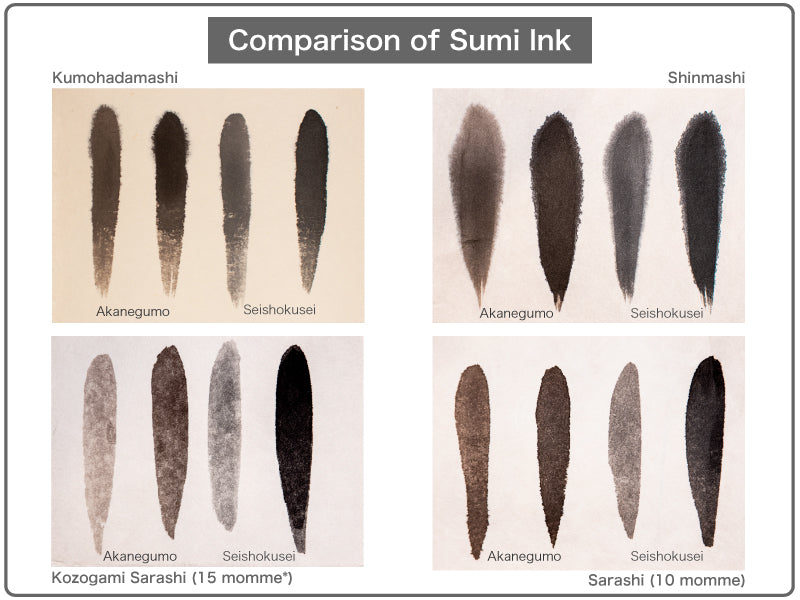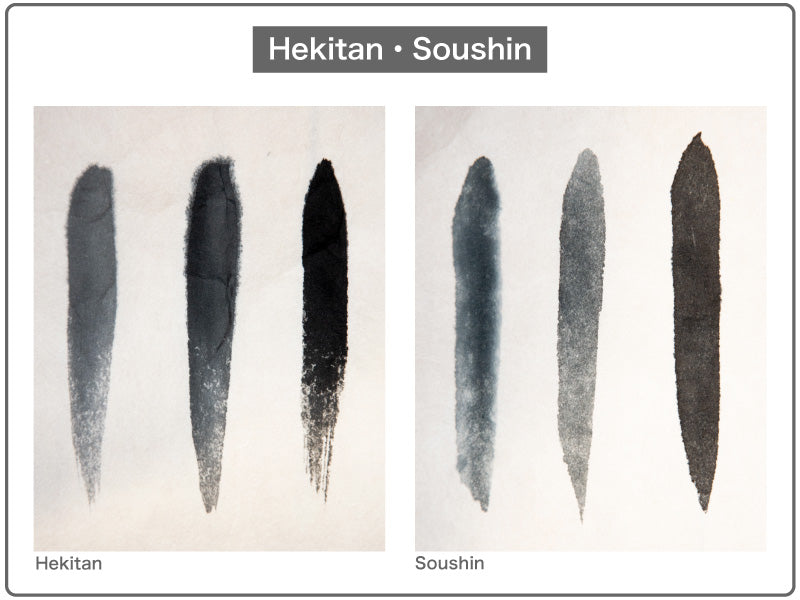Last Updated on December 23th, 2025
Understanding the Rich Variety of Sumi Ink Colors
“Sumi ni *Gosai ari” (墨に五彩あり), which means there are various colors in Sumi ink.
*In Japanese, Gosai (五彩) is a word that refers to an infinite number of colors.
There is a saying that has been handed down since ancient times that there are many different colors of Sumi ink.
When we talk about Sumi ink, the first thing that comes to mind is “black”, but even the same "black" ink contains a rich variety of colors.
There are many theories about the meaning of “Sumi ni Gosai ari,” such as the expression of shading, or the concept of an imagined picture, however, in this article, I will focus on the color of Sumi ink by introducing Ao-zumi and Cha-boku (bluish-black ink and reddish-black ink).
The Traditional Process of Making Sumi Ink
First of all, I would like to explain how Sumi ink is made, from raw materials to the manufacturing process.

Key Ingredients in Sumi Ink: Soot and Animal Glue
The main materials for making Sumi ink are soot and animal glue. Solid Sumi ink is made by kneading these together, forming and drying it.
I believe the most commonly used Sumi ink would be liquid ink and calligraphy pen, which can be easily found and simple to use.
However, there is a big difference between the former and the latter. Some characteristics are unique to solid Sumi ink, such as the shades of color that change over time and as the inkstone is ground.
Types of Sumi Ink Colors: Bluish-Black and Reddish-Black Sumi Inks
There are two types of Sumi ink: bluish-black ink and reddish-black ink, depending on the raw material of the soot and the manufacturing method.
These are so-called "青墨 Ao-zumi/Sei-boku" and "茶墨 Cha-boku".As there are many different kinds of Sumi ink, it is almost impossible to compare and tell the difference and the characteristics of the Sumi ink under their solid-state, and some of them need to be used to know their characteristics better.
In PIGMENT TOKYO, we have many types of Sumi ink, but in this feature, let's use one of them, "Daiwagaboku," for a comparison of colors.
Here is an image of Daiwagaboku being ground, but you can see the difference between ground ink and solid-state in color at this point.
Bluish-Black Sumi Ink (Ao-zumi/Sei-boku)

Reddish-Black Sumi Ink (Cha-boku)

Comparing Bluish-Black and Reddish-Black Sumi Inks
The following picture shows a comparison of "Seishokusei(Bluish-Black Sumi Ink)" and "Akanegumo(Reddish-Black Sumi Ink)" on four different types of Washi (Japanese paper).

Art materials used:
[Sumi ink] Daiwagaboku Seishokusei(Bluish-Black Sumi Ink) / Daiwagaboku Akanegumo (Bluish-Black Sumi Ink)
[Substrate] Kumohadamashi, Shinmashi, Kozogami Sarashi (15 momme*), Kozogami Sarashi (10 momme)
*momme = the measurement of thickness
*Sorry, this item is no longer available.
Kozogami Sarashi (15 momme), Kozogami Sarashi (10 momme)
You can see how the blotting and the colors change little by little depending on the type and thickness of the paper. Although the shades and colors depend on the amount of the ink you used, the lighter the ink, the greater the color difference.
In certain cases, indigo or other pigments are added into Ao-sumi to give the ink a bluer shade, but "Seishokusei" contains the natural blueness of the ink.
On the other hand, “Daiwagaboku Hekitan” contains 本藍(Hon-ai, natural indigo), which gives the ink a beautiful mixed color of indigo and black ink.
Moreover, the blue coloration of "Gaboku Soushin" is a mixture of 藍(Ai, indigo) and other pigments.
*Sorry, this item is no longer available.
Daiwagaboku Hekitan
Here is the picture I painted to show the differences.

As the ink gets lighter, the bluish color of "Soushin" spreads more, giving it a richer ink color that is quite different from "Seishokusei".
Other than the above, there are other options of Daiwagaboku available as follows.
Bluish Black(Ao-zumi)
Reddish Black(Cha-boku)
*Sorry, this item is no longer available.
Daiwagaboku Eiraku, Daiwagaboku Genso
Please refer to the color samples on the product page of Daiwagaboku series to find the perfect shade of Sumi ink for you. These products are also packed in wooden boxes, so you can keep them easily.
The size of the Sumi ink varies depending on the type, but if you are a first-time user or just want to give it a try, we recommend you to buy a smaller Sumi ink.
When using solid Sumi ink(or in this term, we called it inksticks), it is ground with an inkstone.
How to Rub Sumi Ink on an Inkstone
It may seem difficult at first glance, but all you need is Sumi inkstick, inkstone, and water. If you are interested in learning more about this method, please refer to the video below and feel free to have a go!
There isn’t just black and white in Sumi world, instead, it’s rather colorful!
We hope you will enjoy the beauty of Sumi ink that Japanese artisans have painstakingly created one by one using the traditions inherited from past generations and the techniques they have cultivated over the years.
| View Ink Stone products |
| View Sumi Ink products |
Blog articles related to sumi ink can be found below.
PIGMENT ARTICLES














